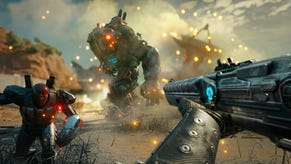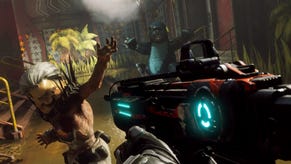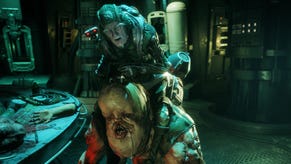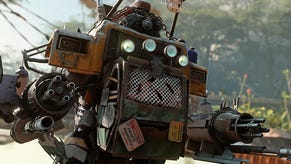Interview - RAGE's Tim Willits
RAGE is id’s first – and apparently only – new IP in quite some time, and the developer’s doing it up in style. Yeah, the post-apocalyptic shooter/driver/toy car driver’s got it all – even its own release date. No more teasing, no more “when it’s done,” no more fooling us into staring into Todd Hollenshead’s dreamy blue eyes until we forget what we were talking about. With RAGE, we’re witnessing the emergence of a new id Software, one that’s not afraid to hunker down and commit.
And we can see why. When you're able to demo your game on three night-and-day different platforms side-by-side, you’re clearly doing something right. With more than a year to go before launch, though, there’s still plenty more to discuss. Is the release date really set in stone? How about multiplayer? Are dedicated servers in or out? What happens if John Carmack goes into space and explodes? We asked RAGE creative director Tim Willits all those questions and more, and he tolerated our shenanigans to the point that we’re pretty sure he wasn’t lying to us!
Check out the interview after the break!
VG247: Yesterday, you announced a release date for RAGE. That’s pretty out of character for id, seeing as I’m pretty sure you guys actually hold trademarks for the words “when,” “it’s,” and “done.” So what changed? Why have you decided to tie yourselves down to that September 2011 date?
Tim Willits: When we were looking at the product and the state that it’s in now – and you saw, it ran pretty fast – historically, when we said “when it’s done,” it’s made it difficult to build momentum up to launch and get the right trade and buyer support stuff. Now, games are like movies. They’re big and they can have big launches. Like the next Harry Potter movie – we already know the date and they just finished filming.
So we need to treat RAGE just like other big entertainment releases. Pick a date, give yourself some flexibility, and then hit that date, so you can build up this huge launch. And then we’re also committed to supporting the title at launch, and then post-launch. Because, you know, a lot of gamers buy games and then they’re like, “Are [the developers] gonna forget about this game?” So we currently haven’t formalized any of our DLC plans, but we architected the game in such a way that we’ll be able to provide some cool content. We also feel that date gives us an opportunity to solidify all our plans.
Again, the “when it’s done” mentality is great, but as we look to the future -- and we look to really making big launches -- it’s not really feasible. And, of course, now people are like, “Cool, I know what I’m doing on that day!”
So the release date is absolutely set in stone? There’s no chance of delay?
Trust me, I would be in deep trouble if this thing got delayed. [Laughs]. Something really bad would have to happen. If John [Carmack] blows himself up in a rocket, we may miss it. [Laughs].
We haven’t seen RAGE’s multiplayer mode yet, but is there a set date for its unveiling? Can we expect it soon-ish?
Looking at what we want to do next year, it’s obvious we want to build up excitement and kind of keep the buzz going. So the multiplayer’s cool, and there’s a group of guys who are busy working on it.
So hopefully soon, but I don’t know the exact date of when we’re gonna talk about multiplayer. I can tell you it’s cool! [Laughs]. Sorry I can’t give you a better answer.
How difficult has it been simultaneously developing for all three platforms? I know you were expecting trouble from the PS3 during yesterday’s demo, and then the Xbox 360 ended up taking a spectacular dive right off the deep end. In an ideal world without piracy and whatnot, would you have just developed the game on PC and left it at that?
Well, I mean, yes, piracy’s definitely a big issue for us. But for me personally, my preferred gaming system right now is the 360. Just because it goes in my media room with a big screen and stuff. I can sit on the couch and put my feet up.
There’s such a huge install base on all these platforms that it would be foolish to ignore them. You know, historically, we were always a PC-centric company, but consoles have gotten to the stage where we can make great games. John can work on this new technology and not feel that he’s in a box. And he says that there are lots of things you can do on the consoles that have never been done before – that he can push his creative genius toward. And the install base is so huge that it would be foolish [to ignore it].
One of the reasons that we’ve had luck getting all the systems up and running as well as we did is that we weren’t taking old technology and cramming it into these systems. Most other companies that have complained about this system or that system are taking PC-centric code that is not multi-threaded, and they have to mult-thread it and shove it into these console systems and it’s a struggle. But with id Tech 5, John Paul and Robert Duffee, from the very beginning, they were like, “Ok, let’s look at the landscape. We’ve got multi-cores over here. We’ve got cores over here. We can do this. So if we do it like this, it’ll work.”
So we haven’t had the types of struggles that you’ve heard of from other developers. One console has some issues, another console has some issues, but in general, it hasn’t been a nightmare. I mean, could you tell any difference between the three systems? Usually, as you know, PS3 games look a bit rough. Also, we were running 8k pages on the PC, which allocates more video memory, so the textures are a bit more crisp. But in general, [they were about the same].
We were happy to come here, put them all up on the screen, and have everybody decide for themselves. Because it’s one thing to go, “Yeah! They look the same! They’ll play the same.” But until you see it…
And what was cool was, you know, Robert played much differently than Jason did. And so you’d see that Matt was using the bomb cars, Jason was using the turrets, Rob was… I don’t know what he was doing. [Laughs]. So you can see that, yeah, there is actually a difference, and you have some choice in what you do and stuff. And that’s nice, because a lot of times, when press guys watch demos, we show them one thing. We’ve got 15 minutes, so we tell them, “Yeah, you’ve got choice. You can do these different things.” But you have to take our word for it.
And especially with this crowd, there’s a high bullshit defense meter going on with the QuakeCon crowd. So it’s good to show it to this crowd, because they’re the ones who are harder to fool. But, what’s also cool with the QuakeCon crowd is – if you have a problem with the 360, like we had to restart it – they didn’t care. Because everybody in the crowd has had something crash on them. [Laughs]. Especially in [QuakeCon’s Bring Your Own Computer area].
As for the game itself, during the demo, you showed a little car combat – which looked awesome, by the way – and a lot of on-foot shooting. What’s the ratio there? Is RAGE mostly a shooter with a little vehicular carnage on the side? Or is it about 50-50?
Well, one of the reasons we didn’t do a lot of driving yesterday is because, honestly, when we first started talking about the game, we talked a little too much about driving, and it got everyone confused. So we drastically kind of shifted our message.
You do spend most of your time running, gunning, and shooting at guys. But if you enjoy the racing circuits, you can spend a ton of time on that. Like at work, there are some guys who love racing. We have this time trial, and in each of these series, there’s always a time trial you can run. You can do them in ATVs and buggies and stuff. And really, all you need to do is get around the track and beat our time, but there are some guys at work that go on and on and on. They’re, like, fighting over milliseconds and stuff.
But really, in the game, if you hate driving and you love running around and shooting things – well, you still have to drive through the wasteland -- but there are only a handful of “you have to do this” races, which is great for player choice. If you’re not a big driving fan, you can probably cut the driving experience down a lot. But if you enjoy the experience, you could probably spend more time driving, since you could do it over and over and over again. If you talk to the bartender in each town, they’ll pay you for every bandit you kill in the wasteland. So you can make a bunch of money that way. Or you can make a bunch of money playing minigames. Or you can do side missions.
So it’s really impossible to say an exact percentage, because it all depends on what you do.
Some of RAGE’s biggest detractors – based on what they’ve seen of it – say the game looks just like Fallout. You know, you’ve got your wasteland, your cataclysm that sent people burrowing into vault-like shelters, etc. What do you say to those people?
For us, the setting exists to support the story, the gameplay, and the action. We picked the setting because, when John was working on the megatexture technology, he downloaded all this terrain data from NASA. We could see the potential of these large kind of landscapes, and we thought, “Yeah, we’ll use that. We’ll drive through those. But with levels where you’ll get on foot. We’ll build those on top of it.” And we wanted to have surprises and guns and sci-fi elements, so a post-apocalyptic world worked out great.
We could have put it on an alien planet. We could have made up a fictional world. But people are like, “I understand this.” You know, this event happened, and there’s a certain context – a certain understanding. So people are like, “Oh, I can accept the world!” And then they play it.
But the setting only exists to support the story and gameplay. What you actually do in the game makes a big difference. And when you play Fallout 3 or Borderlands, you experience a different type of thing than RAGE.
How much of your development process has been devoted to getting id Tech 5 up and running?
Half. Half the time. For us, we can spend four or five years working on a game. Half the time you really spend developing the technology. The other half you spend really making the game.
So it’s definitely a long process. And that’s something we’re trying to improve on with our second team. The theory – and this is actually working out quite well – is that first half of the development time, we can erase that from the Doom 4 development by using the same tech we are. They learn from our mistakes. They’ve got our techniques down. So they can actually make content that’s gonna go in the game. You can imagine now, we work on Doom 4 and those guys are busy working on that. And the RAGE team can either work on some new tech or a different game with the same tech, and you can see that our goal is faster turnarounds with multiple teams.
Back when id Tech 5 was first shown, it was billed as a “next-gen” engine. During his keynote, though, Carmack said that Microsoft and Sony haven’t given you even the slightest glimpse of their next consoles. Was id Tech 5 originally conceived with that “next-gen” in mind? Is it being held back by current-gen consoles?
Well, actually, one of the really great things about the technology is that it’s very scalable. And when John sets out to make technology, he doesn’t look at what other companies are doing. He looks at what he can do and how we can use this going forward. What’s really neat about it is he’s taken the tech and scaled it down to an iPhone, which was really cool – except for those enemy animations. [Laughs].
But it can also be scaled upwards. Without going into too many details, in the future, you can imagine that fewer and fewer devices will have hard drives on them. There will be more cloud-based entertainment. I mean, Apple’s talking about it with iTunes, and Internet speeds are faster. Even with storing all of the data somewhere else, this technology can take advantage of that. It can also be scaled in the sense that, if you take the most badass video card out there right now, we can add tons of different features to really blow it up. So Carmack built the technology to go up and to go all the way down to an iPhone.
We’ll be using this as our core for years. I mean, look at how long Quake 3 technology’s gone on for. So we’re not worried about the legs on id Tech 5.
John was talking about how the iPhone version of RAGE was originally a pitch for a Wii version, but that fell through. He also cited Orcs and Elves on DS as a bit of a sales letdown. So, is id more or less through with Nintendo platforms for now?
Currently, for RAGE, there are no Nintendo plans. But again, like I said, the technology can be scaled in any direction. You can make just about any game with it. So currently, we have no Nintendo plans, but I’m not saying that’s impossible.
Speaking of that word, during his talk, John said he thought dedicated servers for RAGE will be “possible.” Now, the relationship between RAGE and dedicated servers has been a long and sordid tale, and we haven’t really gotten a definitive answer. Is this it? Is John’s word gospel?
You have to take John’s word on that. What John says is what John says. We’ll leave it up to John to answer. But when we have a multiplayer announcement, I think people will kind of be able to get their minds around what we’re working on.
In the RAGE demo, the AI seemed really intense – especially the melee guys, who were dodging around, pinning the player against the wall, and whaling on him. How much of a focus was AI for you this time around? Has it been moreso than on other id titles?
Oh yeah. Here, let me show you with my VIP badges. [Gestures]. The [melee] guys are the ones who were dodging back-and-forth and they were really acrobatic. The scorchers here, you know, as you can see, this guy’s pretty heavily armored. So they don’t do as much dodging, but they take a ton of damage. And they’ll also send bomb cars after you and things like that. The Wasted clan, you know, these guys – what they lack in tech, they make up for with personality. And then, the mutants, of course, have different characteristics with different sizes.
So yes, AI’s been really important for us, because, you know, in the past we’ve had zombies and demons. When you have mostly human-based enemies, you need to make them much smarter. If a demon’s doing something silly, you can get away with it, but when humans do it, [not so much]. So we really focused on making sure that each of the bandit clans has a unique fighting style and the experience is unique – so that you’re not just fighting the same guy over and over again.
While the RAGE iPhone demo was very impressive, one thing did stand out to me: it took place in a small, constrained corridor-style room. Will the final game be more of a corridor shooter? Or will it be the complete RAGE package, with open areas, vehicular combat, and whatnot?
Some of the id Tech 5 tech, like I said, scales down to the iPhone. It won’t be the entire RAGE experience – like it won’t be the same game, but on the iPhone. But it will be very RAGE-y. RAGE-ish. [Laughs].
And that’s one of the reasons we built the RAGE universe the way that we did. Like I said in my panel, historically, we made games that start and end, and that’s really the whole story. But with RAGE, we wanted to create this world where you can have other characters that you play, you can have other parts of the timeline that you play. We can exploit something like Mutant Bash TV or the racing more.
So, by building this rich and colorful world that existed before the main character in our game arrives and you can feel will continue to exist after the game ends, we set ourselves up to make versions of games on the iPhone that take place in the universe – like Star Wars. There’s all kinds of different Star Wars games that take place in the same universe. That was our goal with RAGE and the universe we created.

















